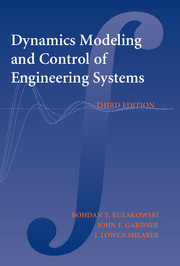Book contents
- Frontmatter
- Contents
- Preface
- Dynamic Modeling and Control of Engineering Systems
- 1 INTRODUCTION
- 2 MECHANICAL SYSTEMS
- 3 MATHEMATICAL MODELS
- 4 ANALYTICAL SOLUTIONS OF SYSTEM INPUT–OUTPUT EQUATIONS
- 5 NUMERICAL SOLUTIONS OF ORDINARY DIFFERENTIAL EQUATIONS
- 6 SIMULATION OF DYNAMIC SYSTEMS
- 7 ELECTRICAL SYSTEMS
- 8 THERMAL SYSTEMS
- 9 FLUID SYSTEMS
- 10 MIXED SYSTEMS
- 11 SYSTEM TRANSFER FUNCTIONS
- 12 FREQUENCY ANALYSIS
- 13 CLOSED-LOOP SYSTEMS AND SYSTEM STABILITY
- 14 CONTROL SYSTEMS
- 15 ANALYSIS OF DISCRETE-TIME SYSTEMS
- 16 DIGITAL CONTROL SYSTEMS
- APPENDIX 1 Fourier Series and the Fourier Transform
- APPENDIX 2 Laplace Transforms
- APPENDIX 3 MATLAB Tutorial
- APPENDIX 4 Simulink Tutorial
- Index
10 - MIXED SYSTEMS
Published online by Cambridge University Press: 05 June 2012
- Frontmatter
- Contents
- Preface
- Dynamic Modeling and Control of Engineering Systems
- 1 INTRODUCTION
- 2 MECHANICAL SYSTEMS
- 3 MATHEMATICAL MODELS
- 4 ANALYTICAL SOLUTIONS OF SYSTEM INPUT–OUTPUT EQUATIONS
- 5 NUMERICAL SOLUTIONS OF ORDINARY DIFFERENTIAL EQUATIONS
- 6 SIMULATION OF DYNAMIC SYSTEMS
- 7 ELECTRICAL SYSTEMS
- 8 THERMAL SYSTEMS
- 9 FLUID SYSTEMS
- 10 MIXED SYSTEMS
- 11 SYSTEM TRANSFER FUNCTIONS
- 12 FREQUENCY ANALYSIS
- 13 CLOSED-LOOP SYSTEMS AND SYSTEM STABILITY
- 14 CONTROL SYSTEMS
- 15 ANALYSIS OF DISCRETE-TIME SYSTEMS
- 16 DIGITAL CONTROL SYSTEMS
- APPENDIX 1 Fourier Series and the Fourier Transform
- APPENDIX 2 Laplace Transforms
- APPENDIX 3 MATLAB Tutorial
- APPENDIX 4 Simulink Tutorial
- Index
Summary
LEARNING OBJECTIVES FOR THIS CHAPTER
10–1 To integrate knowledge of mechanical, electrical, thermal, and fluid systems to model physical systems made up of more than one type of element.
10–2 To model coupling transducers as ideal and nonideal devices.
10–3 To use state or input–output models to analyze performance of translational–rotational mechanical, electromechanical, and fluid mechanical systems.
INTRODUCTION
In previous chapters, various types of systems were discussed, each within its own discipline: mechanical, electrical, thermal, and fluid. However, many engineering systems consist of combinations of these elementary single-discipline system elements: electromechanical, fluid mechanical, and so on. To combine single-discipline systems, it is necessary to use coupling devices that convert one kind of energy or signal to another: mechanical to electrical, fluid to mechanical, and so on.
The general term “transducer” will be used here for ideal coupling devices. In cases in which significant amounts of energy or power are involved, these coupling devices will be referred to as energy-converting transducers; when the amount of energy being transferred is minimal, they will be referred to as signal-converting transducers.
Selected nonideal energy convertors, which are modeled graphically, are also discussed in terms of typical characteristic curves that have been derived from performance tests.
ENERGY-CONVERTING TRANSDUCERS AND DEVICES
The energy-converting transducers introduced here are ideal in that they are lossless models that contain no energy-storage or energy-dissipation elements. When energy storage or energy dissipation is present, these effects are modeled with lumped ideal elements connected at the terminals of the ideal transducer.
Information
- Type
- Chapter
- Information
- Dynamic Modeling and Control of Engineering Systems , pp. 249 - 272Publisher: Cambridge University PressPrint publication year: 2007
